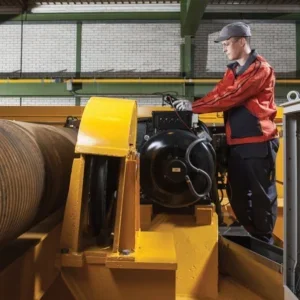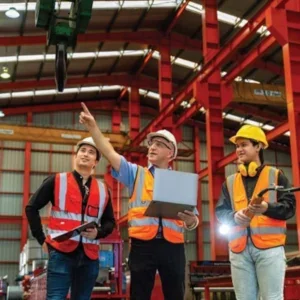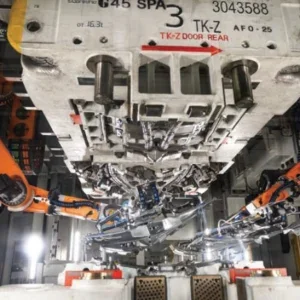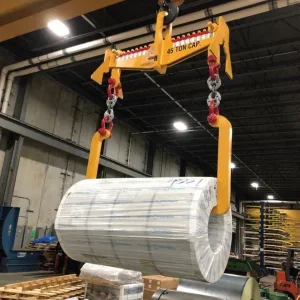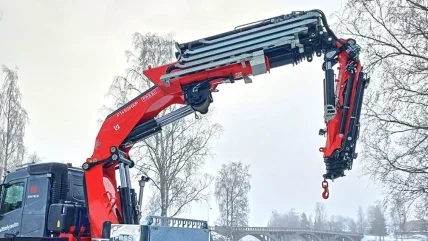
Over the last few years Latin America has been affected by a recession and a series of political changes. Some countries have been hit more than others, but there is a general slowdown in industrial investments.
“It is no secret that the materials handling market has been heavily hit by these issues and new strategies must be developed,” says Karsten Hönack, Stahl’s area sales manager in Latin America. “An increasing presence of competitors looking for better markets bring additional challenges into this constellation. But only the best suppliers with solid engineering and a close customer relation will do the long term run.
“Due to low raw material prices many projects have been set on hold and maintenance jobs have increased as machinery needs to run over the operational lifetime and be overhauled at site.”
Harrington Hoists vice president of sales Jim Small says, “The Chilean economy continues to recover strength after the interruption suffered by the mining strike at the beginning of 2017,” says Small. “The economy still suffers from the lack of investment in previous years. Assuming that the economy will progress in the remainder of the year, average growth will only reach 1.5% in 2017, slightly less than 1.6% recorded in 2016. The Chilean economy will record its fourth year of continuous deceleration.
“In Argentina, after the severe crisis of the early 2000, the economy had a rapid growth, and then slowed. However, after a low growth in 2015, the country re-entered recession in 2016, with -1.8% growth.
Argentina has considerable potential in raw materials, such as lithium, and the world’s second-largest shale gas reservoir and biggest in South America.
“In Peru, 60% of exports are mining and almost half of these exports are copper, which is why the price of copper is the most influential economic variable. Private investment is currently around 14.4% and is projected to reach 17.6% next year, focused mainly in mining industry, which goes along with the growth of 2.5% expected for 2017.
“In Ecuador the official closing of 2015 had a fixed GDP decrease by 1.7% and for the year 2016 projected a negative rate of 2.1%. The main cause of this deterioration has been the fall in international prices of raw materials, oil being the most important for Ecuador.
“Mexico is very unpredictable at the moment. The NAFTA renegotiations, the national elections for President in Mexico in 2018, the tax bill currently being discussed in the US, are all affecting daily operations due to uncertainty.
“Even the USD/MXP exchange rate can change radically with any sort of news regarding the above mentioned subjects. The Mexican economy is very tied to the US economy; if the USD does well, the Mexican economy tends to also do well as most of their exports are sent to the US.
“If the NAFTA trade agreement were to be cancelled, if left-leaning politician López Obrador is elected next year in Mexico— and he has been leading the polls and discussing mimicking Venezuela in Mexico— or if the barrel of oil were to stay under $50, it will be a difficult few years for Mexico.”
Regional Challenges
Small says: “Both foreign and local investment have been down in the regions where we are no longer seeing a 30%+ investment as we used to have in 2012, 2013 and 2014.
“This caused numerous projects to stall due to lack of funds. Internal politics is also a big problem in countries like Ecuador or Colombia, where banks didn’t allow companies to use their own money.
“In Argentina companies couldn’t import any products because the government was attempting to increase the local market. This caused consumers to only purchase products with low quality, technology and warranty on their products.
“In Mexico there is significant uncertainty due to potential NAFTA renegotiations, next year’s presidential elections, the US Tax bill currently being discussed, and oil prices.” Luis Henrique, general manager of GH Brazil, explains that the Latin America region is very sensitive due to the political evolution of its countries.
“It seems that we will now have a certain degree of overall stability, as we wait for the Brazilian and Mexican outlook to clear definitively with the new elections,” Henrique says.
“For us, this region is basic to our growth strategy and we maintain our commitment to strengthen our presence there. In addition, we are actively considering plans for growth in some countries, and we do not rule out growth in any of them.”
Columbus McKinnon marketing manager Oseir Garcia explains that they supply manual and hoist and electric chain hoists to the Latin American region.
“On these areas there are two main risks: the Trump effect and the high dependency of key countries on exports to US,” says Garcia.
“The automotive sector is at risk due to protectionist measures from the Trump administration.”
Hönack believes that another relevant problem in Latin America are small noncertified pseudo crane builders starting in backyard shops without any knowledge about crane building.
“Their quality and prices are low,” Hönack says.
“Also, unqualified service centres are a headache for sophisticated electronics. In a price-oriented market they become a welcome player for purchasers. In the middle-term users will claim operational and service problems and come back to quality products and service.
“Import restrictions and embargos can be also considered as a handicap in LATAM markets. We face a colourful discrepancy between the nations on views of what can be imported and what should be targeted with high taxes.”
Projects in Action
GH México sales manager Guillermo Ruiz explains that GH has several facilities in Mexico.
“One of the most outstanding customers is one of the top American companies, who has bought so far about 90 cranes, with another 11 cranes currently being manufactured for them,” says Ruiz.
“Another installation is at Integrity Tool and Mold for which two 50t cranes have been put at work. This is a Canadian customer that is dedicated to the manufacture and repair of injection molds.”
Jaso Industrial Cranes has supplied 14 bridge cranes for the long steel plant of Siderúrgica Latino Americana in São Gonçalo do Amarante, Brazil.
As a global engineering company serving the largest steel producers in more than 30 countries, Russula was in charge of carrying out this turnkey project for the Brazilian company Silat, one of the main steel producers of the country.
“Russula relied on the experience and know-how of Jaso in the steel sector for the start-up of the long steel mill,” says Fernandez.
“We installed eight double-girder open winch cranes and six single-girder wire rope hoists cranes of different capacities and spans for the rolling mill project, from the handling of billet and corrugated material, to shipment.”
End Use Sectors
García says GH cranes serve all sectors of the manufacturing economy and, therefore, the company is very present in the sectors related to public works, the metalmechanic industry, and sectors that are ancillary to the car sector and others: “The area where we are seeing more growth is in the steel sector, in the public works sector, and in the solutions for the mining industry sector, which is beginning to take off again with the recovery of raw material prices,” says García.
Small explains the mining industry is not growing as it grew in 2013-2014 when companies bought new units in order retool their fleets.
“With the current economy where the price of copper and other materials are being fixed due to the Chinese demand, mining industries are no longer buying new units but instead are repairing and fixing their existing equipment,” says Small.
“When prices for raw materials rise, most economies in South America will benefit.
“In Mexico the industrial activity is stable and the economic output keeps hovering at around 2%.”
New Technology
Small says that in the mining sector, Harrington Hoists have been supplying explosion proof hoists and manual hoists equipped with safety features. In the industrial manufacturing sector the company is introducing the new EQ electric chain hoist, with a wide range of voltages that can be used all over the Americas, such as 380V-50Hz in Argentina, Bolivia and Chile and 230V-60Hz in Ecuador, Peru and Colombia.
“In the automotive industry we have been pushing hard with our air hoists and now also the EQ hoist,” says Small. “Another product we have been successful with is the ATEX air hoist for oil and gas industries, which has received a lot of interest in Argentina.
“In Mexico we have supplied our full line of products and we are seeing consistent growth with our newer products as well, such as below the hook lifting devices and wire rope hoists.
“Our products are sold in these markets due to the higher quality as most of our competitors are lower priced.”
Hönack says Stahl’s customers such as Caterpillar (Finning, Gecolsa, Ferreyros) and Komatsu have foreseen the needs and offer service facilities close to mines.
“They use reliable Stahl CraneSystems components for their cranes as they know about the hard environment they face in far-off regions as the Atacama Desert.
“Stahl CraneSystems’ low-cost maintenance and extremely seldom downtime are welcome and well known in the Latin American market.
“Mining, oil and gas, construction suffer under the circumstances of the slowdown and face a loss of productivity.”
As an industrial business group, which manufactures hoists, overhead cranes and components for cranes, Spain-based GH has a sales network throughout the Americas. Its own factory is based in Mexico and covers sales to the countries of Central America. GH marketing manager Garbiñe Guerra explains that the entire American continent is a priority for the company as the cultural ties and sales exchanges that have arisen historically between Spain and the countries of Central and South America.
Henrique at GH Brazil explains that the “star product” is the standard crane with between 5t and 100t of capacity.
“This, for us, is the crane that can be quoted from our web platform and does not need the intervention of our engineering and design department,” says Henrique.
“However, we are also growing in terms of specialized cranes for the steel sector and other custom solutions like those required in the mining sector which, for many countries, is the backbone of their economies.”
Raul Fernandez, corporate commercial director, Jaso Industrial Cranes, says that the company is present in the Latin America region, notably in Mexico where it has operated for 25 years and Argentina, where it has been present for 20 years.
Jaso supplies industrial cranes and wire rope hoists with many different configurations to the automotive sector and other industries, and heavy duty cranes to the iron and steel industries and energy sector.
Fernandez says: “The most demanding lifting technology in these countries are wire rope hoist with lifting motors in two speeds but day by day, the demand of frequency inverter motors in lifting is increasing.
“Jaso covers this demand with their V Range Hoist, our latest development focused in having more accuracy, longer life and security in the daily handling of the loads,” says Fernandez.
“Additionally, Jaso has experienced an increase of the demand of heavy duty cranes for the iron and steel sector and mainly of their flagship ‘Ladle and Furnace Cranes’.
“The demand of automation solutions is increasing and nowadays, Jaso can develop fully automated cranes for production, logistics and material handling in general.”
Industry Demands
Victor Saucedo, Street Crane’s business development manager in Latin America, southern and western states, explains that they have seen a demand for a range of different Street Crane products, especially in industry sectors such as mining, oil, gas, power, metalworking, renewables and automotive.
“Street’s LX series of electric chain hoists are popular for less intensive applications as these can lift up to 5t,” says Saucedo.
“For more demanding operations, our ZX series hoists are required to lift up to 80t.
“We also get requests for full ZX crane kits, which are exported from the UK and provide our customers with everything they need to build a complete overhead crane, except the steelwork for the main bridge girder.”
Saucedo explains that technology is an important consideration for customers in the region to help improve productivity and minimise downtime.
“That’s one of the factors driving enquiries for Street’s products as they have been designed with many technological features as standard,” says Saucedo.
“These include hoist condition monitoring units and variable frequency drives (VFD). These can also be integrated with Street Crane’s anti-sway software, providing a high level of load control and virtually eliminating swing.”
Saucedo adds that over the last year, Street Crane products have been supplied for a variety of projects. Some examples include Kia’s new manufacturing plant in the northern Mexican state of Nuevo Leon, Beta San Miguel’s new sugar mills in the southern Mexican state of Veracruz, Soletanche Bachy’s new plant in the central Colombian estate of Cundinamarca, and Codelco’s new waste treatment plant in the central Chilean state of Región.
Small says Harrington’s customers are demanding new technologies such as VFD in their electric chain hoists. “Our new EQ has it incorporated in all units including single phase,” says Small.
“Our NER—which has been in the market since 2008—has it standard for dual speed units.
“The developing countries are also requesting true food grade units for food production. We are able to satisfy these requests with our NER-FG line of food grade electric chain hoists as well as our AL series of food grade air hoists.”
Small believes that the 10-year warranty on the company’s Guardian brake, other competitive warranty offers, and easy sourcing from its well-stocked US warehouse, are a big factor in attracting customers.
Small says that in the north of Chile there is a new Chinese copper mine where Harrington supplied numerous explosion proof electric chain hoists.
“In Mexico we have supplied products to an expanding tyre manufacturing facility, brand new Japanese automotive plant, and, interestingly enough, a new and expanding toy manufacturer,” Small says.
GH Mexico general manager Pere García also sees customers in the region choosing feature-rich cranes: “Frequency inverters in all motions, the anti-sway system, the Corebox system for data processing and transfer, and other technological advances that are standard inclusions in our products make GH a brand committed to the profitability of our clients.
“Likewise, there is the GH ‘Customer Portal’ service, developed for the comprehensive management of equipment breakdowns and maintenance in the most effective and fastest way possible through the use of new communications technologies. This system provides centralized document management and optimizes the real relationship with our service technicians.
“This system is already up and running for some customers on the Spanish market and we hope to add it very soon for the customers of all these Latin American countries.”


